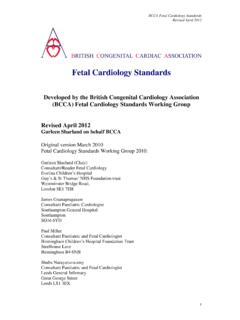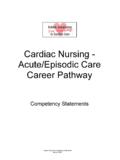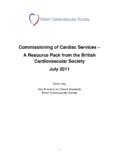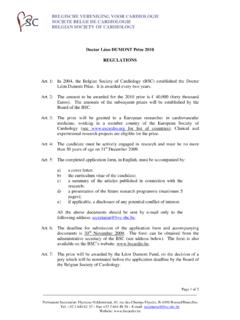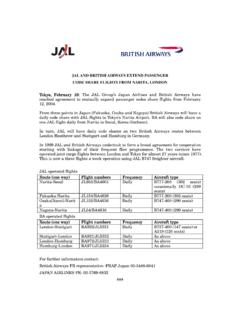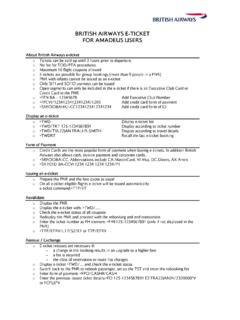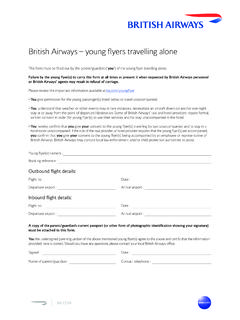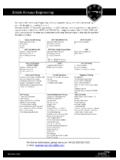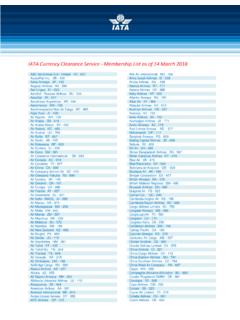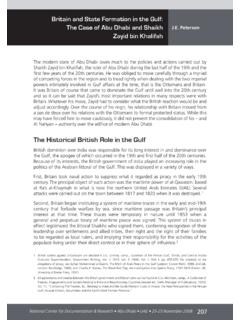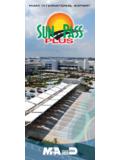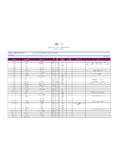Transcription of Fitness to fly for passengers with cardiovascular disease
1 The report of a working group of the BritishCardiovascular SocietyFitness to fly for passengers with cardiovascular 6/26/10 7:49 PM Page 1 Guidance at a glanceConditionFunctional statusLay explanationRestriction/guidanceAnginaCCS angina IeIIChest pain on considerable exertion withno recent change in symptoms ormedicationNo restrictionCCS angina IIIC hest pain on minimal exertion with norecent change of symptoms or medicationConsider airport assistance and possiblein-flight oxygenCCS angina IVChest pain at rest or a change insymptoms and/or medicationDefer travel until stable or travel withmedical escort and in-flight oxygenavailablePost-STEMI and NSTEMILow risk: age<65, first event, successfulreperfusion, EF>45%, no complications,no planned investigations or interventionsIf you have had a heart attack but you areaged<65 years, the blocked artery hasbeen opened, the heart pump is not badlydamaged and no further tests or treatmentare plannedFly after 3 daysMedium risk: EF>40%, no symptoms ofheart failure, no evidence of inducibleischaemia or arrhythmia, no plannedinvestigations or interventionsIf you have had a heart attack, your heartpump is quite good and you have nosymptoms of breathlessness or chest painand no other tests or treatments areplannedFly after 10 daysHigh risk.
2 EF<40%, signs and symptomsof heart failure, those pending furtherinvestigation, revascularisation or devicetherapyIf you have had a heart attack, the heartpump is significantly damaged and youhave symptoms of breathlessness or youare waiting for further tests or treatmentDefer travel until condition stableElective PCI uncomplicatedYou have had the heart arteries treatedwith a balloon and stent and there are nocomplicationsFly after 2 daysElective CABG uncomplicatedAllow for intrathoracic gas resorption. Ifcomplicated or symptomatic, see heartfailureYou have had heart bypass surgery andtime must be allowed for any air in thechest to be absorbedFly after 10 days if no complications. Ifsymptomatic, follow guidance for specificsymptomsAcute heart failureYou have been in hospital or treated athome because of water in the lungs which made you very breathlessFly after 6 weeks if stabilised (see chronicheart failure)Chronic heart failureNYHA I and IIYou get breathless on mild to moderateexercise but no recent (within 6 weeks)change of symptoms or medicationNo restrictionNYHA IIIYou get breathless on walking 20e100yards/metres at your own pace but norecent (within 6 weeks)
3 Change ofsymptoms or medicationMay require in-flight oxygenNYHA IVYou are breathless at rest and mainlybedboundAdvised not to fly without in-flight oxygenand medical assistanceCyanotic congenital heart diseaseNYHA I and IIYou have congenital heart disease withblue blood and get breathless on mild tomoderate exertion but no recent (within6 weeks) change of symptoms ormedicationMay require in-flight oxygen*NYHA IIIYou have congenital heart disease withblue blood and get breathless on walking20e100 yards/metres but no recent(within 6 weeks) change of symptoms ormedicationConsider airport assistance and mayrequire in flight oxygen advisable*NYHA IVYou have congenital heart disease withblue blood and are breathless at rest andmainly bedbound but no recent (within6 weeks) change of symptoms ormedicationAdvised not to fly without in-flight oxygenand airport assistance available*Valve disease (see heart failure)Following pacemaker inplantationIf you have had a temporary or permanentpacemaker there is a risk of the lung beingpunctured.
4 If it has not been punctured,you can fly after 2 days. If it has, then youshould wait until 2 weeks after it has fullyhealedFly after 2 days if no pneumothorax. In theevent of a pneumothorax, flying should bedeferred for 2 weeks following completeresolutionFollowing ICD implantationIf you have had a defibrillator, the sameadvice for pacemakers (above) appliesbut, in addition, you should not fly afterthe ICD has delivered a shock until yourcondition is considered stableThe same advice as for pacemakersabove but, in addition, rhythm instabilityshould be treatedArrhythmiaStableIf you get occasional palpitations that donot cause fainting and have not recentlybecome more frequent or you have anirregular pulse which is treated and stableNo restrictionContinuedFitness to flyContinuedConditionFunctional statusLay explanationRestriction/guidanceAblation therapyIf you have had an ablation (burn)procedure to get rid of your palpitationsyou can fly after 2 days.
5 If flying within1 week of the procedure, you shouldconsider yourself at high risk of formingblood clots and talk to your doctorFly after 2 days*New York Heart Association (NYHA) grading of heart failureCanadian cardiovascular Society (CCS) grading of anginaNYHAS ymptomCCSS ymptomINo limitation of physical activity and noshortness of breath when walking orclimbing stairsIAngina only during strenuous or prolongedphysical activityIIMild symptoms of shortness of breath andslight limitation during ordinary activityIISlight limitation, with angina only duringvigorous physical activityIIIM arked symptoms of shortness of breathduring less than ordinary activity (eg,walking 20e100 yards). Comfortable onlyat restIIIS ymptoms with everyday living activities(ie, moderate limitation)IVSevere limitation of activity withsymptoms at restIVInability to perform any activity withoutangina or angina at rest(ie, severe limitation)*Consider at high risk of , coronary artery bypass graft; CCS, Canadian Cardiac Society; DVT, deep vein thrombosis; EF, ejection fraction; ICD, implantable cardioverter defibrillator; NSTEMI, non-ST elevationmyocardial infarction; NYHA, New York Heart Association; PCI, percutaneous coronary intervention; STEMI, ST elevation myocardial infarction.
6 VTE, venous for the avoidance of deep vein thrombosis and venousthromboembolismBlood clots (DVTand VTE)Risk criteriaRisk reduction advice forpassengersLow riskNo history of DVT/VTENo recent surgery (4 weeks)No other known risk factorKeep mobile. Drink plenty ofnon-alcoholic drinks. Do notsmoke. Avoid caffeine andsedative drugsModerate riskHistory of DVT/VTES urgery lasting>30 min4e8 weeks agoKnown clotting tendencyPregnancyObesity (BMI>30 kg/m2)As for low risk with theaddition of compressionstockingsHigh riskPrevious DVT with knownadditional risk includingknown cancerSurgery lasting>30 minwithin the last 4 weeksAs for moderate risk butsubcutaneous injections ofenoxoparin 40 mg before theflight and on the following dayBMI, body mass index; DVT, deep vein thrombosis.
7 VTE, venous to flyFitness to fly for passengers with cardiovasculardiseaseDavid Smith,1 William Toff,2 Michael Joy,3 Nigel Dowdall,4 Raymond Johnston,5 Liz Clark,6 Simon Gibbs,7 Nick Boon,8 David Hackett,9 Chris Aps,10 Mark Anderson,11 John Cleland12 SUMMARYF ollowing this review of evidence and after due consideration, it is clear that there are few cardiovascularconditions that warrant the denial offitness tofly as a passenger . Given the right aircraft, on-boardequipment and appropriately qualified and experienced escort personnel, aircraft can act asflying intensivecare units and carry extremely ill those with cardiovascular disease who are not critically ill but who wish tofly on commercialaircraft, the aircraft environment does not pose a significant threat to their health.
8 It is only when theirunderlying condition is associated with a significant risk of acute deterioration that reasonable restrictionsshould apply. For those at the more severe end of the spectrum of their specific cardiovascular condition,services exist to help make the journey more easily and safely. Most carriers and airport authorities provideassistance on the ground and in the air. Oxygen is available on most major carriers, although this issometimes subject to a charge and at least 7 days notice is normally are advised to plan their arrival at the airport in plenty of time to avoid having to rush and towarn the carrier and/or airport authority of any requirements for assistance, including requirement forin-flight oxygen, well in advance of the date of departure.
9 They are strongly advised to ensure they have anappropriate supply of their medication, a clear list of the medications and doses they take and a letter ofexplanation from their doctor regarding their condition, drugs, allergies and devices (eg, pacemaker).Physicians are advised to consider the stability of a passenger s condition and apply the authors have contributed to this document in good faith and consider it to be an honest conclusion ofthe review of evidence and assessment of the risks. It is guidance only and responsibility for declaring a patientfit to travel rests with the attending airline carrier should always be informed if a sick passenger is intending tofly. It has a right to refuse thecarriage of a passenger at its own discretion, even if they technically fulfil these guidelines recommendationsshown This Working Group of the british Cardiovas-cular Society was established to produce a report onPassenger Fitness to Fly in response to the House ofLords Science and Technology Committee report onAir Travel and Health3in which it is suggested thatspecialist cardiology guidance would be of assis-tance to general practitioners, passengers andpassenger carrying organisations when determiningthe risks of passengerflight for those with cardio-vascular There are many existing guidelines on passengerfitness tofly.
10 4e7most of which include somereference to certain cardiovascular disorders, butthere is variation in the recommendations, partic-ularly in the time required to elapse between anevent or medical procedure and There is a lack of clarity over the purpose ofthe current guidelines. The suggestion by theHouse of Lords Committee on Air Travel andHealth that there be specialist cardiology guidanceis vague about the overall goal of the are widespread concerns among the publicthat air travel has the potential to be harmful,many of which are expressed by the House of Lordscommittee and are reflected in the following Although passengerflight is commonplace,the aircraft cabin provides what might be consid-ered a relatively alien, restrictive and hostile envi-ronment.

